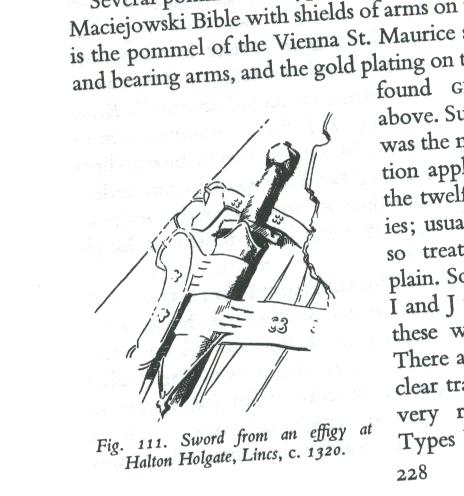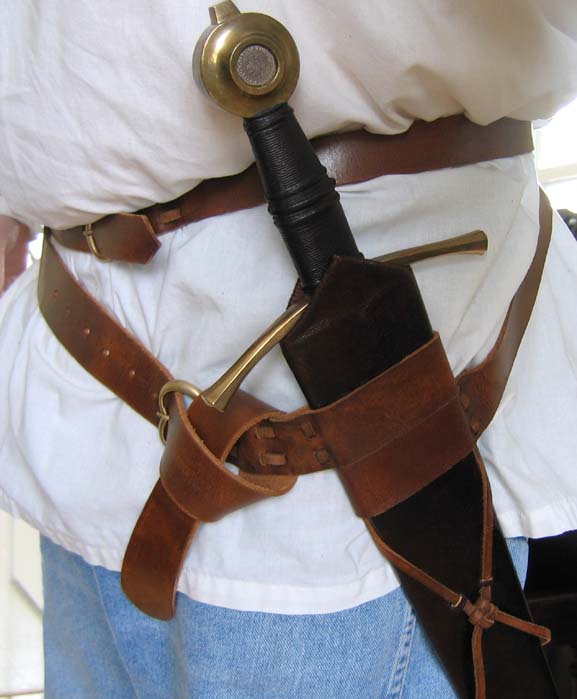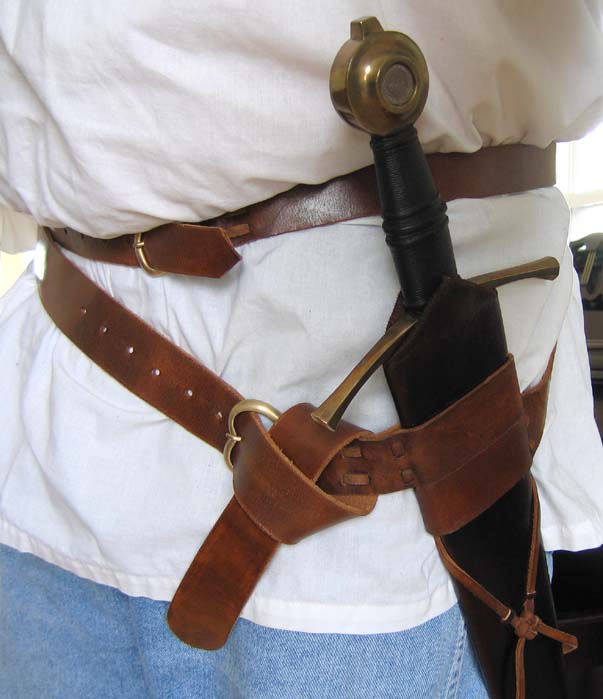| Author |
Message |
|
Dave Smith
|
 Posted: Mon 11 Feb, 2008 6:43 pm Post subject: Sword Suspension Posted: Mon 11 Feb, 2008 6:43 pm Post subject: Sword Suspension |
 |
|
I'm currently recreating a 2 belt suspension system similar to what was used in many kingdom of heaven costumes. I've been able to come up with some (not much) information of this being a 12th century rig (maybe used in the 13th century as well?). Unfortunately, I'm not at all familiar with this set-up and was wondering if any of the more knowledgeable minds here could explain how the weight distribution worked.
Does the upper belt need to sit above the hips?
Does the lower belt need to sit at a definite slant, or sit somewhat parallel to the upper one?
What was the common method for connecting the two belts?
Any and all information is appreciated.
The current set-up is very similar to the belt good ol' Orlando is wearing here:
http://www.theorlandobloomfiles.com/pictures/...ook_01.jpg
Note: Apologies that the picture does not showcase the belt that well, it was the best I could find.
|
|
  |
 |
|
Sean Smith
|
 Posted: Mon 11 Feb, 2008 7:30 pm Post subject: Posted: Mon 11 Feb, 2008 7:30 pm Post subject: |
 |
|
|
Link says no hotlinking.
|
|
  |
 |
|
Dave Smith
|
|
  |
 |
Ed Toton

|
 Posted: Tue 12 Feb, 2008 7:44 am Post subject: Posted: Tue 12 Feb, 2008 7:44 am Post subject: |
 |
|
| Sean Smith wrote: | | Link says no hotlinking. |
One way around this is to right-click the link, and select "Copy link location" (or equivalent), and then paste the link into the browser's link bar. Most sites allow a "blank referral". It's when you're clicking through from another site that it's restricted in most cases.
-Ed T. Toton III
ed.toton.org | ModernChivalry.org
My armor photos on facebook
|
|
   |
 |
Chad Arnow
myArmoury Team


|
 Posted: Tue 12 Feb, 2008 8:23 am Post subject: Posted: Tue 12 Feb, 2008 8:23 am Post subject: |
 |
|
This kind of suspension may have survived into the 14th century:

I had a version of it recreated:


More pics can be found here:
http://www.myArmoury.com/talk/viewtopic.php?p=65346#65346
Mine is set up so the main belt rides at the waist line. Having the lower belt at an angle will help it hang better, I think. My rig is actually all integral, cut from the same length of leather. Around part of my back and my right hip, it's one wide belt; it splits off to form the lower belt.

ChadA
http://chadarnow.com/
|
|
    |
 |
Steven H

|
 Posted: Tue 12 Feb, 2008 1:45 pm Post subject: Posted: Tue 12 Feb, 2008 1:45 pm Post subject: |
 |
|
Hello,
Do you have pictures of the back?
Thanks,
Steven
Kunstbruder - Boston area Historical Combat Study
|
|
   |
 |
Chad Arnow
myArmoury Team


|
 Posted: Tue 12 Feb, 2008 2:13 pm Post subject: Posted: Tue 12 Feb, 2008 2:13 pm Post subject: |
 |
|
| Steven H wrote: | Hello,
Do you have pictures of the back?
Thanks,
Steven |
I'm assuming you're talking to me.  If so, I do not currently have pictures of the back. It's not terribly interesting actually. If so, I do not currently have pictures of the back. It's not terribly interesting actually.  The entirety of the belt (save the buckled strap end attached to the scabbard) is one piece, just cut so it makes four strap ends branching off from one piece. The spot you can't see in that pic is that one wide piece. The entirety of the belt (save the buckled strap end attached to the scabbard) is one piece, just cut so it makes four strap ends branching off from one piece. The spot you can't see in that pic is that one wide piece.

ChadA
http://chadarnow.com/
|
|
    |
 |
Elling Polden

|
 Posted: Tue 12 Feb, 2008 3:40 pm Post subject: Posted: Tue 12 Feb, 2008 3:40 pm Post subject: |
 |
|
It seems orlando is wearing two unconected belts.
However, it replicates a style shown in high medevial art, where the sword belt hangs quite low on the hip.
What I've found is that this is best done by wearing a regular belt, and a sword belt with two rear risers.
You simply pass the regular belt between the risers, which means that it will hang in place no mater how much you loosen the buckle (or knot.)
Front;

Back;

"this [fight] looks curious, almost like a game. See, they are looking around them before they fall, to find a dry spot to fall on, or they are falling on their shields. Can you see blood on their cloths and weapons? No. This must be trickery."
-Reidar Sendeman, from King Sverre's Saga, 1201
|
|
    |
 |
|
Dave Smith
|
 Posted: Thu 14 Feb, 2008 8:46 pm Post subject: Posted: Thu 14 Feb, 2008 8:46 pm Post subject: |
 |
|
Chad- Thanks for that information! I honestly did not think of the two belts actually being part of the same belt.
Elling- I think I follow what you're saying, but it all hinges on the meaning of the word "risers". What exactly are you referring to?
All- Thanks a ton for the replies. It's definitely helping the project come together.
|
|
  |
 |
|
|

